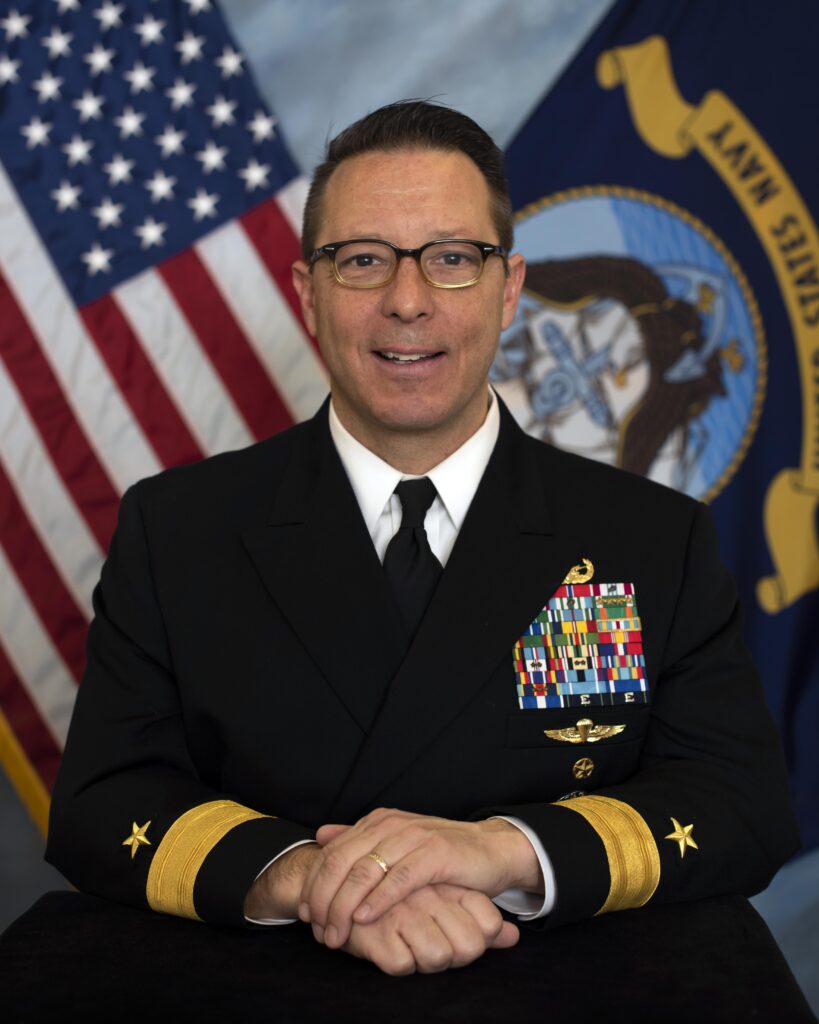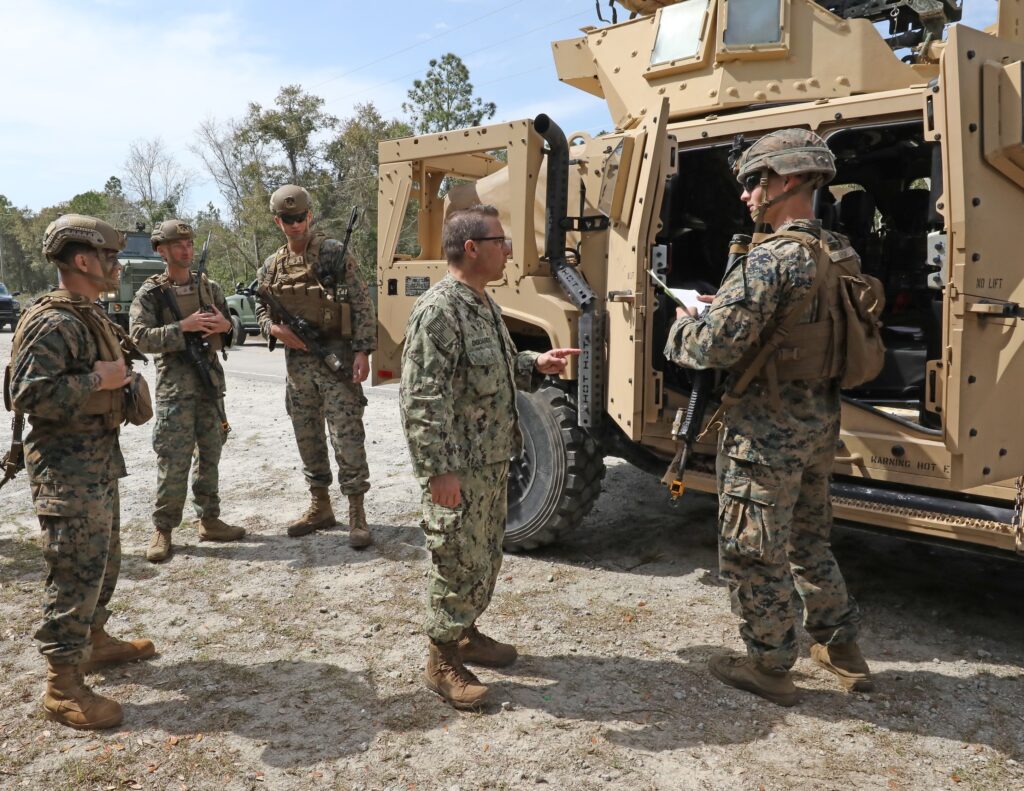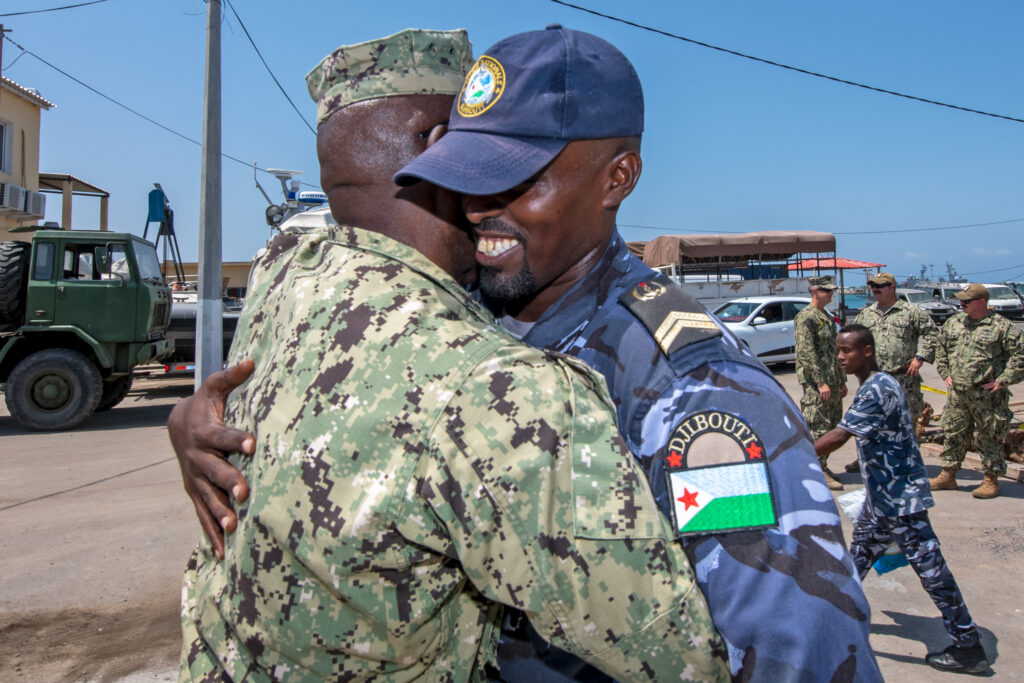
Rear Adm. Joseph A. DiGuardo Jr. serves as commander, Navy Expeditionary Combat Command. A native of Fallston, Maryland, he received his commission and graduated from the U.S. Naval Academy in 1991 with a Bachelor of Science in history. He commenced explosive ordnance disposal training in February 1995. He also holds a Master of Science in national security strategy from the National War College. He is a designated EOD officer with qualifications as a special operations officer, master EOD technician, surface warfare officer, naval parachutist, basic diving officer and combat craft patrol officer.
DiGuardo’s sea duty and operational assignments include officer in charge, Special Boat Unit 12; auxiliary and electrical officer, USS Frederick (LST 1184); OIC, EOD Mobile Unit 8 Detachment, Bahrain; special projects officer, Joint Special Operations Command; executive officer, EOD Mobile Unit 2; deputy director, Counter Improvised Explosive Devices Task Force, U.S. Central Command; commanding officer, EOD Mobile Unit 11; and commodore, Navy Expeditionary Combat Forces Central, Task Force 56, where he was made an honorary chief petty officer. He has completed eight combat deployments in support of Operations Enduring Freedom, Iraqi Freedom and commander, U.S. 5th Fleet.
His shore assignments include OIC, Navy Counter IED Center of Excellence, Joint IED Defeat Organization; director, Navy Warfare Group, OPNAV N515; branch head, Navy Expeditionary Combat, OPNAV N957; vice deputy director, Global Operations (J39), Joint Chiefs of Staff; and director, Countering Weapons of Mass Destruction Fusion Cell, U.S. Special Operations Command.
DiGuardo responded to questions from Senior Editor Richard R. Burgess.
How is NECC affected by the end of U.S. participation in the war in Afghanistan and reduction of presence in Iraq and Syria?
DIGUARDO: There are really two sides to this coin. First, for things like force design and force employment, we’re taking a look across the entirety of NECC to ensure we’re adjusting our force as necessary to continue operating in support of integrated all-domain American naval power. Adaptability has always been a key component of our expeditionary forces, and it’s one of the main reasons our men and women are so good at what they do. As the big picture shifts and our mission sets change, we’re being very calculated and deliberate in how we build in timing, scalability, tempo and flexibility to ultimately deliver a more agile force for our Navy and the joint force and a more capable, less predictable one to our adversaries.
The other side of that coin is that while we understand the need to adjust to the new mission priorities, we cannot forget that many of our men and women had vital roles in places like Iraq and Afghanistan over the past two decades. It’s always going to be a part of them. It’s essential that we remind them that just because our role in a conflict has ended, it doesn’t mean the work they did to get there was done in vain. I wrote a letter to our force reminding them of that fact shortly after the withdrawal from Afghanistan.
It said we believe oppression and tyranny must always be fought against, because their defeat, whether it lasts two weeks or 20 years, is a worthwhile endeavor. That is what we saw in Iraq and Afghanistan, where we were joined by a coalition of more than 40 other nations — all in pursuit of freedom — for us and for others.
How is NECC affected by the new emphasis on high-end capabilities to counter China and Russia?
DIGUARDO: Our “what and why” have not changed … the “where and how” is evolving based on the environment and changes to Navy strategy.
Navy Expeditionary Combat Forces exist to conduct and support fleet operations by dominating in the littorals and reinforcing maritime lethality. NECF will clear the battlespace of hazards; secure critical maritime terrain, sea lines of communication and resources; build infrastructure, awareness, logistics chains and partnerships; and protect the fleet, facilities and joint, allied and partner forces.
The Maritime Sustainment Vector model aligns the logistics enterprise with standing and developing naval concepts related to DMO [distributed maritime operations]. These vectors are core activities which provide a framework to inform the development of a more agile and resilient logistics force — one that better enables the Navy to compete in ways that are sustainable and integrated with the joint force, allies and partners in a high-end maritime conflict. NECF employs smaller, less detectable, less expensive and more risk-tolerant logistics platforms to enable the transfer of sustainment from afloat and shore based expeditionary nodes to warfighting forces in the contested environment.
NECF performs the “Rs” required for effective DMO in contested and austere areas enabling integrated American naval power to keep the fight forward.
Refuel: Fuel fleet units to ensure agility in force projection through distributed maritime operations.
Rearm: Rearm fleet units to ensure persistent lethality in the distributed maritime fight.
Resupply: Sustain fleet units to keep them on station in the distributed maritime fight.
Repair: Rapidly repair battle damage to fleet units and critical infrastructure to return them to the fight.
Revive: Sustain force end-strength preventing injury and illness through Force Health Protection measures and rapidly triage, diagnose, treat and evacuate or return medical casualties to the force.
Rebuild: Replace or reinforce infrastructure for Expeditionary Advanced Base Operations.
How do the new Expeditionary Advance Base Operations and Distributed Maritime Operations concepts affect the roles of NECC?
DIGUARDO: The chief of naval operations’ NAVPLAN says there are six critical elements for successful DMO. They are repair, resupply, refuel, rearm, revive and rebuild. The NECF has a significant role in delivering each of these in the austere environments of the ANB [advance naval base] and EAB [expeditionary advance base].
Our ability to integrate with our Marine Corps teammates and provide essential support and expertise to the EABO model has been on display a lot in the last year through a variety of exercises and experiments.

What changes, if any, are affecting the Naval Construction Battalions and the Naval Expeditionary Logistics Force?
DIGUARDO: Across the board, we’re making the force more lethal, resilient, sustainable, survivable, agile and responsive as 2022 National Defense Strategy describes and CNO NAVPLAN implements.
As EABO and ANB continues to evolve, it’s becoming clearer to those operating in the battlespace just how essential NECF is in reinforcing DMO lethality.
Our role at the last tactical mile, ensuring logistics nodes are sustained through things like airfield damage repair and port damage repair efforts, is where our support of the fleet and joint force is so important. Our ability to adapt to complex and austere environments, scale the size of our necessary forces and remain agile to evolving mission requirements is something consistent across our force.
Our Seabees within the Naval Construction Forces and logistics experts at Navy Expeditionary Logistics Support Group are essential to building the infrastructure necessary to enable and sustain operations forward.
In recent wars, EOD provided critical support to operations on land. Is that focus changing more in the direction of maritime operations?
DIGUARDO: We’re always going to adapt to any new requirement, and today with strategic competition driving a greater need for emphasis in the maritime environment, that’s where we’re putting a lot of our focus.
Maritime traffic is increasing, new sea lanes are opening and with our adversaries getting more creative and autonomous in how they can disrupt that environment, the need for Navy EOD is greater than ever.
Operating in the maritime arena, and all the nuances and complexities that come with it, though, are nothing new to us. That’s what sets Navy EOD apart — we are uniquely qualified to understand those challenges, overcome them and do our part to reinforce maritime lethality.
Our expeditionary mine countermeasures capability is increasingly important to the fleet and provides a fast, scalable and adaptable option for clearing threats away from our ships and forces. This is one area where this particular skillset allows us to use the enduring EOD knowledge to remove old threats in the maritime arena, but learn about, develop and introduce emerging technologies that will better equip us in the high-end fight ahead.
All that said, the Navy still owns a role as the Joint Service EOD executive agent, so we have responsibilities across the entiretyof Department of Defense. We are also mindful not to forget the hard lessons learned while operating in Iraq and Afghanistan. While much of our focus for Navy EOD may be in the maritime environment for the foreseeable future, we have a responsibility to ensure proficiencies across the full spectrum of operations.
How is the new 40-foot patrol boat an improvement over the boats it is replacing? How many are being procured?
DIGUARDO: The current platform was a speed to fleet procurement that was not fully suited for the missions performed and has reached end of useful service life.
When looking at a replacement, there was a need for a platform specifically designed to meet the needs of our mission requirements.
These boats and our operators serve a significant role for our force and for the fleet in operating at sea, in harbors, rivers, bays and across the littorals while conducting maritime expeditionary security operations across all phases of military operations.
They defend and protect high value units, critical maritime infrastructure, ports, and harbors both inland and on coastal waters against enemies as well as conduct operational plan level missions and sustained day-to-day security in all force protection threat levels. The initial contract is for 56 boats, which could grow to 120 over the next 10 years.
Why does the Navy plan to remove its Mark VI patrol boats from service?
DIGUARDO: The Navy analyzed the Mark VI’s ability to compete against a near-peer adversary as part of the strategic alignment analysis that is the beginning of the POM [program objective memorandum] process for every fiscal year. Navy ship procurement focuses on a force structure that aligns with the demands of the National Defense Strategy, and the Navy determined the savings from divesting of Mark VI could be better invested in higher priority platforms better suited for competition with a near-peer adversary.
Why did the Navy retire its riverine boat force?
DIGUARDO: Like many of the other topics we’ve discussed, this was just part of the ongoing refinement of our Navy Expeditionary Combat Force to maximize the efficiency of our warriors and their ability to deliver in the high-end fight.
This particular mission set with the riverine force was generated to support Marine Corps operations as part of Operation Iraqi Freedom, and as that requirement wound down, we took those proficiencies, the lessons we learned from it, and applied them in a way that was more relevant to battlespace we were transitioning into.
Our Maritime Expeditionary Security Forces continue to play an essential role every day in anti-terrorism/force protection operations across the globe and in support of our fleets.
What would be needed to reconstitute the riverine force if needed?
DIGUARDO: If ever asked to reconstitute a riverine mission, it would require the equipment, training, and methods we used to generate the Riverine force for Iraq. We have done so before and could do so again. However, we do not anticipate this and remain focused on our MESF core missions.
How are unmanned systems being used by NECC?
DIGUARDO: We are increasingly utilizing unmanned systems across our force. This is done to modernize the technology that our warfighters are familiar with, but also to enhance their capabilities they bring to the fight.
Clearing the battlespace of explosive, physical and security hazards is one of our main lines of operation. Unmanned technology extends our organic sensor range, increases our area coverage and improves our detect-to-engage sequences at the front of those efforts, while mitigating risk to our operators.
Much of our effort has been in in the underwater realm in support of expeditionary mine countermeasure operations with things like UUVs [unmanned underwater vehicles] and ROVs [remotely operated vehicles], but we continue to explore platforms outside of that and other mission areas for application of that technology.

With that said, we’re always exploring opportunities to experiment with and identify potential areas of unmanned aerial and surface technology that would effectively integrate into our force.
What role, if any, does NECC have in training foreign forces in operation of patrol boats, EOD operations and other expertise?
DIGUARDO: One of SECNAV’s enduring priorities is for us to strengthen strategic partnerships, and we’re certainly doing that.
Although the Navy divested from the Maritime Civil Affairs and Security Training Command in the early part of the last decade, and even without a specific command coordinating those efforts within NECC, our men and women continue to build partner capacity through subject matter expertise exchanges and exercises with partner nation forces around the world.
These exchanges are effective, and the relationships and partnerships that result are truly authentic. There’s a photo from late last year where we had Maritime
Expeditionary Security Squadron 11 conducting a six-week professional maritime orientation course to the Djiboutian navy, and the photo shows one of their guys hugging our master chief at the end of it. There was gratitude and joy, but more importantly, a relationship.
That photo is validation of the importance of those types of exchanges. Not only that, but now there are 15 more Djiboutian sailors with a better level of technical aptitude in an extremely critical part of the world.
And our EOD take advantage of some of those same training and interoperability opportunities to continue our partnership initiatives and the long-term benefits that come from doing them.
What aspect of NECC do people find the most surprising?
DIGUARDO: NECC’s relevancy to current fight. It is not all about carriers, submarines and airplanes. Those are essential components of American naval power, but for NECC, our people are our weapons system. Much of what they do is in support of those larger platforms, but NECF do so through operations forward, in austere environments, while integrated with the joint force, allies and partners, or in concert with our Marine and Coast Guard teammates.
The fleet needs our Navy Expeditionary Combat Forces to close the last tactical mile so those vital platforms never run out of fuel, ammunition or other needed supplies. They need us to clear, secure, build and protect across the spectrum of operations.
We’re already doing that, but what might come as a surprise is how widespread that support is. In 2021
alone, we had more than 5,300 NECF Sailors deployed forward to 55 countries, supporting 64 requirements generated by six geographic and two functional combatant commands. That is enabling DMO lethality.
Our forces clear, secure, build and protect for the fleet and joint force. NECC is uniquely qualified to deliver at the time and point of need, often exclusive capabilities, to support integrated American naval power.
- Insitu Going Strong at 30, Focusing on Maritime Operations - April 8, 2024
- Navy Awards Boeing Additional Funds for MQ-25 Drones for Testing - April 3, 2024
- Benign 4th Fleet AOR Useful for Unmanned Vehicle Operationalization, Admiral Says - March 27, 2024




